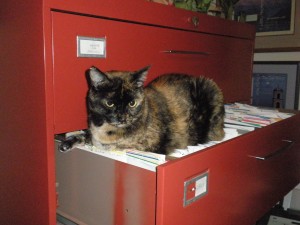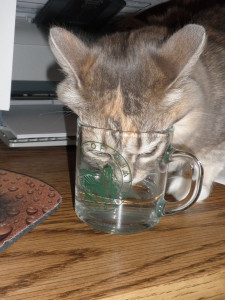 If you’ve lived closely with cats for very long, you’ve seen a cat in distress—a urinary tract problem, abscess, ear mites, fleas, or injury, perhaps. And you’ve learned that your cat seems extremely tolerant when it comes to pain. In fact, most of the time a cat hides pain quite well. But the better you know your cat, the more likely you are to recognize when something’s wrong.
If you’ve lived closely with cats for very long, you’ve seen a cat in distress—a urinary tract problem, abscess, ear mites, fleas, or injury, perhaps. And you’ve learned that your cat seems extremely tolerant when it comes to pain. In fact, most of the time a cat hides pain quite well. But the better you know your cat, the more likely you are to recognize when something’s wrong.
I’ve carted cats off to the vet even before there were signs of distress the vet could detect. He would suggest I take the cat home and keep an eye on her. Sure enough within a day or two, the cat was running a fever or not eating or she had another symptom the vet could use to identify the problem.
So what are some of the signs that your cat is in discomfort or pain? I remember one  morning noticing that my Himalayan was continually licking one of her paws. I checked and discovered she had an ingrown dew claw.
morning noticing that my Himalayan was continually licking one of her paws. I checked and discovered she had an ingrown dew claw.
Have you ever seen your cat take on the meatloaf position and stay there for hours on end? When my Persian did this and quit eating, I hauled her to the vet and we found she had swallowed a needle. So now, an extended period of time in the meatloaf position and obsessive licking along with not eating are some of the keys I watch for when I have a cat that seems to be in distress.
What are some of the others? Dilated pupils and maybe squinting, staying out of bright light, hiding, continuous purring, avoiding jumping up on furniture are some. Here are some good sites for learning more about how a cat responds or reacts to pain.
http://www.pet365.co.uk/blog/9-signs-your-cat-is-in-pain/
https://www.sciencedaily.com/releases/2016/02/160226085759.htm

OLYMPUS DIGITAL CAMERA
So how can you protect and care for your cat? Keep your veterinarian’s phone number handy. Post it for your pet sitter and give him or her the parameters for when to and when not to call the vet. Most of all, keep a close eye on your cat.
- Groom her regularly so you are familiar with her body and in order to discover problem areas.
- Check to make sure her ears are clean and free of mites.
- Carefully monitor her at feeding time. Be aware of changes in her habits such as excessive drinking.
- Feel for lumps, scrapes, and touchy places when petting her.
- Call the vet early when your cat seems to be in distress.
Remember that your cat may seem self-sufficient, but she still relies on you to maintain her health and well-being.





